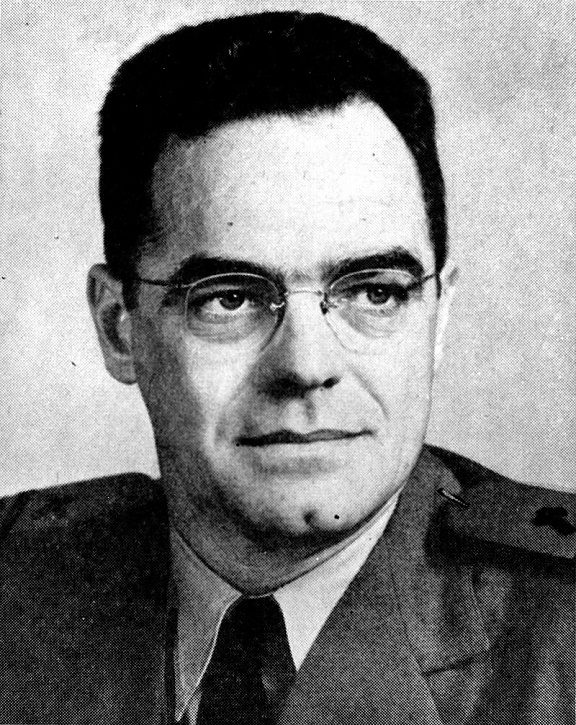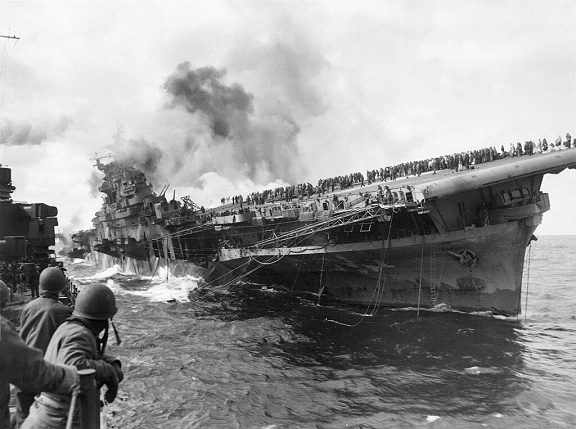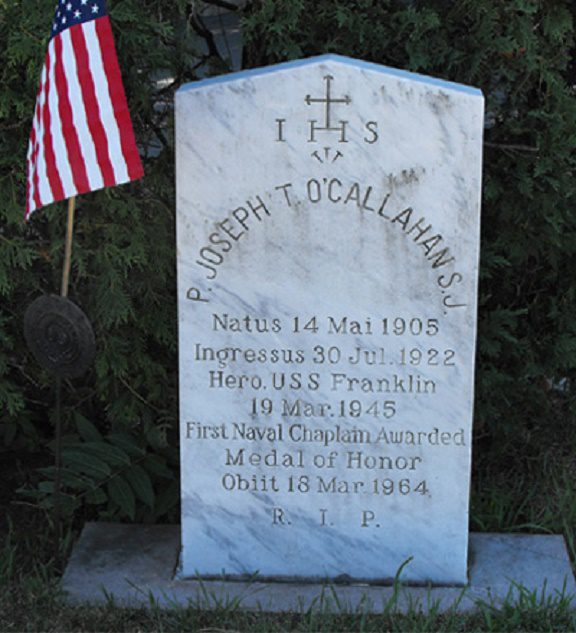By James Heinz
On February 19, 1964, the destroyer escort USS O’CALLAHAN was launched at the DeFoe shipyard in Bay City, Mich. She was the first warship named after a priest and the first christened by a Catholic nun. The nun had spent World War II in a Japanese prison in the Philippines while her brother fought to free her. He was the first U.S. Navy chaplain to receive the Congressional Medal of Honor, and he was someone you have probably seen in World War II documentaries.
Photo at top of page: The USS O’CALLAHAN (FF 1051) underway in 1988 courtesy of Wikipedia

O’Callahan gives last rites to crewman on USS FRANKLIN, March 19, 1945 courtesy of Wikipedia
Many of those documentaries show a brief black and white film clip of a man wearing a helmet with a white cross on it kneeling over the motionless body of a sailor lying on the alarmingly tilted flight deck of an aircraft carrier. That man was Lt. Cmdr. Father Joseph T. O’Callahan.

Lt_Cmdr. Joseph T. O’Callahan, USNR courtesy of Wikipedia
O’Callahan was born in 1905 in Boston, Mass. He joined the Jesuit order in 1922 and received a master’s degree in physics and mathematics in 1937. He taught at several Catholic colleges. One of his students John Power would also receive the Medal of Honor posthumously.

Attack on the carrier USS FRANKLIN, March 19, 1945, courtesy of Wikipedia
O’Callahan joined the Navy in 1940. By 1945 he had risen to the rank of lieutenant commander and was aboard the aircraft carrier USS FRANKLIN CV-13. What happened next can best be described in the words of his Medal of Honor citation:
“For conspicuous gallantry and intrepidity at the risk of his life above and beyond the call of duty while serving as chaplain on board the U.S.S. Franklin when that vessel was fiercely attacked by enemy Japanese aircraft during offensive operations near Kobe, Japan, on 19 March 1945. A valiant and forceful leader, calmly braving the perilous barriers of flame and twisted metal to aid his men and his ship, Lt. Comdr. O’Callahan groped his way through smoke-filled corridors to the open flight deck and into the midst of violently exploding bombs, shells, rockets, and other armament. With the ship rocked by incessant explosions, with debris and fragments raining down and fires raging in ever-increasing fury, he ministered to the wounded and dying, comforting and encouraging men of all faiths; he organized and led firefighting crews into the blazing inferno on the flight deck; he directed the jettisoning of live ammunition and the flooding of the magazine; he manned a hose to cool hot, armed bombs rolling dangerously on the listing deck, continuing his efforts, despite searing, suffocating smoke which forced men to fall back gasping and imperiled others who replaced them. Serving with courage, fortitude, and deep spiritual strength, Lt. Cmdr. O’Callahan inspired the gallant officers and men of the Franklin to fight heroically and with profound faith in the face of almost certain death and to return their stricken ship to port.” This went on for over 11 hours.

Courtesy of Find a Grave
The Navy offered him the Navy Cross for his actions but he refused it, saying he deserved the Medal of Honor. The public agreed, and in 1946 President Truman awarded him the Medal. O’Callahan never recovered from his wounds and while in the hospital he was tended by the sister of John Power, who was also a nun. He died in 1964.
A few years ago, I saw the same helmet he is wearing in the film clip and his rosary beads on display aboard the museum ship USS YORKTOWN in Charleston, SC.
The USS O’CALLAHAN was a GARCIA class destroyer escort. She displaced 3,400 tons and was 415 feet long and 44 feet wide. She could make 27 knots for 4,000 miles. She was armed with two 5 inch guns, 8 missile tubes, six torpedo tubes and an early example of a military drone that carried depth charges. She was reclassified as a frigate FF-1051 in 1975. She was transferred to Pakistan in 1989 and scrapped in 1994. After her launch, she never returned to the Great Lakes.
_______________
James Heinz is the Wisconsin Marine Historical Society’s acquisitions director. He became interested in maritime history as a kid watching Jacques Cousteau’s adventures on TV. He was a Great Lakes wreck diver until three episodes of the bends forced him to retire from diving. He was a University of Wisconsin – Milwaukee police officer for thirty years. He regularly flies either a Cessna 152 or 172.

